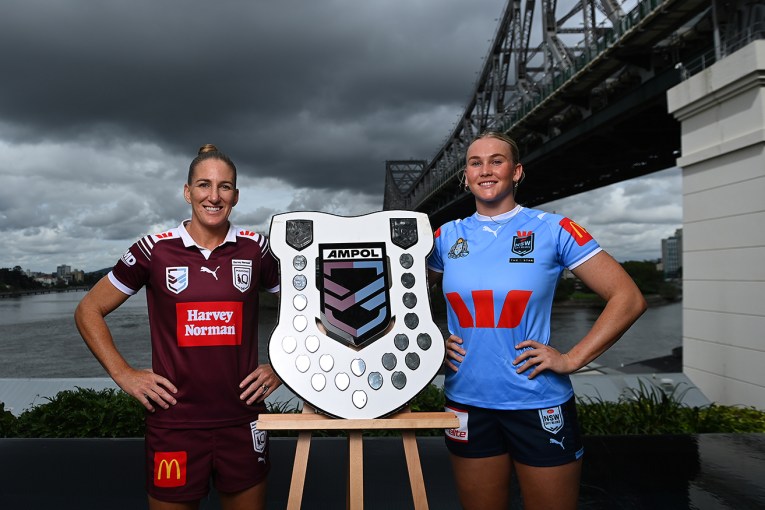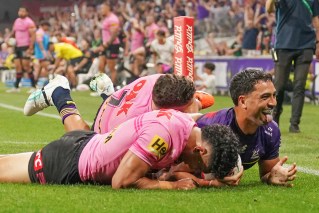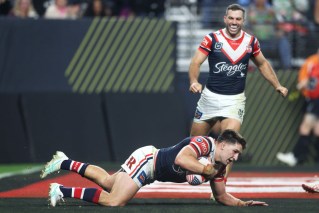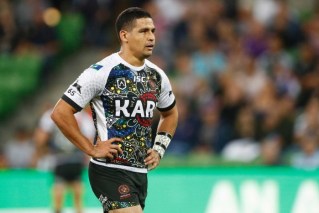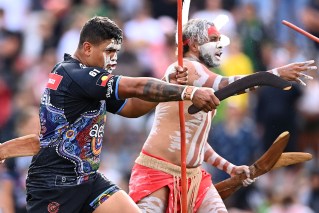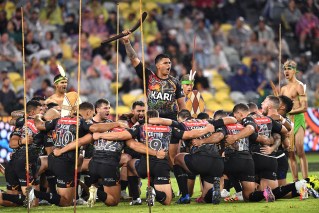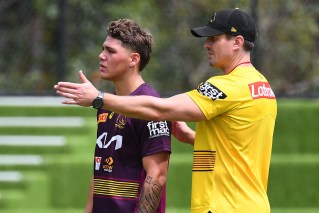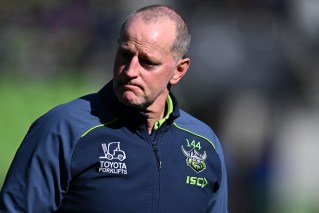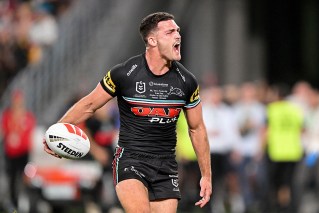Kangaroos war cry: Inside the Australian team’s new pre-match ritual

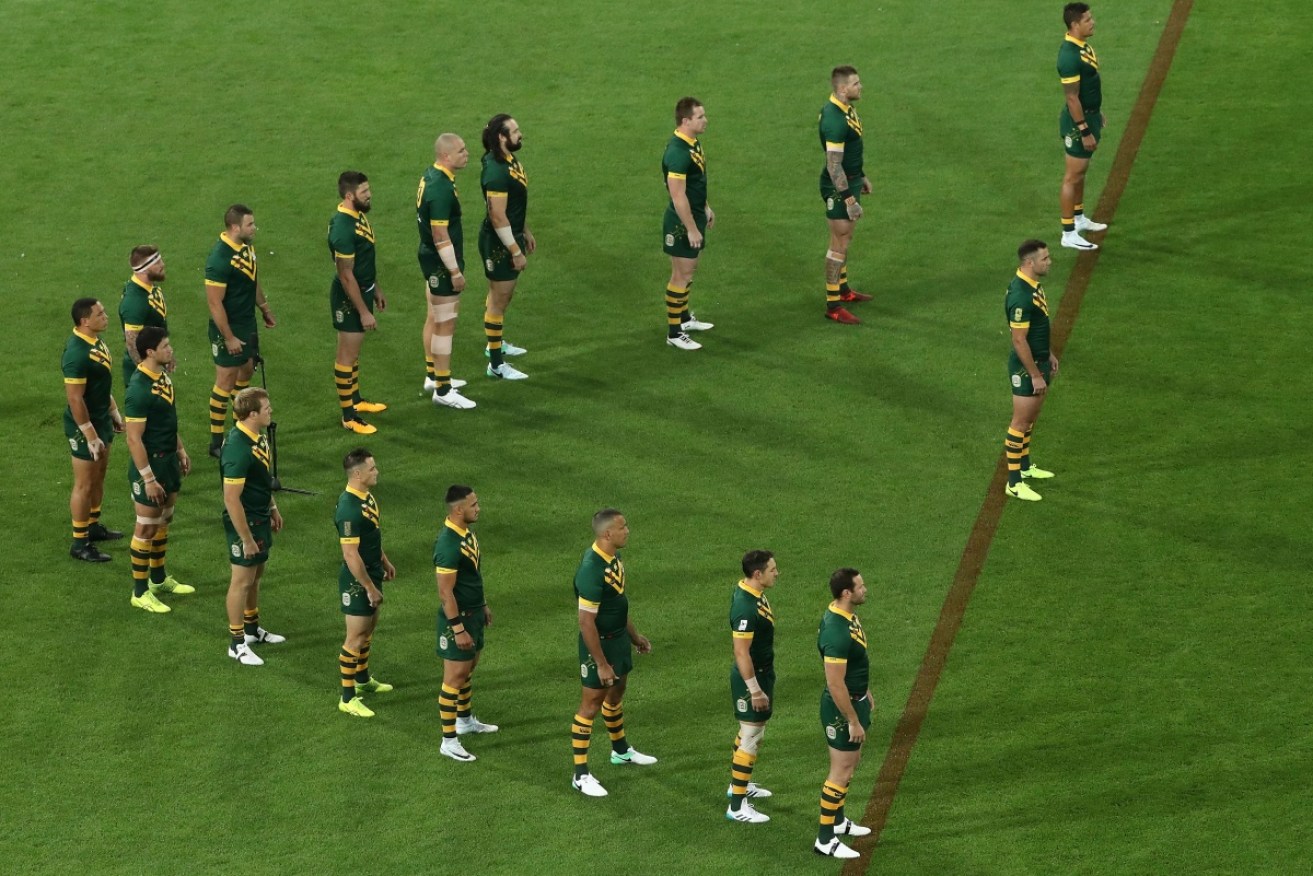
Australia lines up during the 2017 Rugby League World Cup match against England in Melbourne on Friday. Photo: Getty
The Kangaroos opened the Rugby League World Cup with a stunning pre-game performance before beating England 18-4 in Melbourne on Friday.
And while the choreographed on-field display combined elements seen in other pre-game war cries, it was very much a modern version.
Watch the video here
Australian @Kangaroos' Acknowledgement of Country – Led by @camsmith9 & Johnathan Thurston. #RLWC2017 pic.twitter.com/J53trI2jPX
— 7RLWC (@7RLWC) October 27, 2017
So, what was the ritual about?
Injured Kangaroos star Johnathan Thurston is the brains behind it, with the 34-year-old – widely regarded as the best player in the world – explaining in the build-up that “this is about uniting the team [and] also what we stand for.
Thurston also outlined how much symbolism they were trying to incorporate into what he referred to as an acknowledgment of country.
“The history of Australia, the chevron, the coat of arms, the Anzacs,” he said.
“Being of indigenous descent, I’m very proud of my heritage and I’m very proud of my country as well.
“It’s acknowledging the traditional owners of our country but also welcoming the other nations that are going to be playing on our soil.”
Rugby league great Laurie Daley believes the concept has real value – because it’s been driven by the players.
Daley, named at five-eighth in the Indigenous Team of the Century, believes the indigenous elements are important, but the intent of the ritual was much broader.
“I think it’s more about rugby league being an inclusive game and recognising all parts of our history and heritage,” he told The New Daily.

Laurie Daley made 26 appearances for Australia. Photo: Getty
“It’s to be inclusive, to feel like we’re together, we’re all a part of Australia, this is our history, let’s embrace it, let’s move forward with it, and let’s get on with reconciliation and being able to embrace everyone’s culture.
“If everyone understands what it’s all about, I think it’s a very powerful tool.”
There will only ever be one haka
Inevitably, some will refer to the display as Australia’s version of the haka. After all, New Zealand’s national teams have well and truly claimed the pre-game war cry space as their own.
Ka mate, the haka most associated with rugby’s All Blacks, was composed by one of New Zealand’s most famous chiefs, Te Rauparaha, after his escape from an enemy tribe some 200 years ago.
The All Blacks have intimidated opponents and thrilled fans with ka mate for more than a century.
Many New Zealand teams, including rugby league’s Kiwis, the Tall Blacks in basketball, and field hockey’s Black Sticks, perform a haka prior to games.
The Kiwis traditionally used the ka mate version before adopting a haka of their own, Te Iwi Kiwi, starting at the 2013 Rugby League World Cup.
Other national teams have their own war cries
One of the highlights of the NRL’s Representative Round in May 2015 was the clash between Samoa and Tonga at Cbus Super Stadium on the Gold Coast, more specifically the pre-game.
The two passionate Pacific island sides faced off before the start of the match, the Samoans with their Sivi Tau and the Tongans with their own Sipi Tau war dance.

Tonga will perform their war dance at this year’s World Cup. Photo: Getty
The two nations’ rugby union teams also perform these traditional dances before matches, as does the Fiji team with its Bole (accepting a challenge) or Cibi (a celebration of victory by warriors).
Australia has tried to develop one of its own in the past.
At the start of the 20th century, the touring Wallabies and Kangaroos adopted a war cry that was described as being fairly theatrical, with the rugby league one performed until 1967.
‘The English used to love it’
In 2003, league legend John Raper told the Sydney Morning Herald that he still remembered every word of Wallee Mullara Choomooroo Tingal.
“The English used to love it but the French even more. It was like performing on stage. It was very fearsome; you had to do the actions of an Aborigine,” Raper recalled.
Many of the words – recounted by sports historian Ian Heads in his book The Kangaroos – were particularly aggressive:
We are a race of fighters descended from the War Gods
Beware! Beware! Beware! Beware!
Where we fight there will be great bloodshed
Go! Go! Go! Go!
We are powerful but merciful; are you friends?
Good! Good!
The kangaroo is dangerous when at bay
Come on. Come on, to death
Times have changed
One can only wonder how the sight of non-indigenous players doing ‘the actions of an Aborigine’ en masse prior to a sporting contest would be received in 2017.
Australians, in general, are far more sensitive to indigenous culture and certainly on the sporting field, where so many players with indigenous heritage play prominent roles, respect is paramount.
Something quite significant started within the Australian rugby league camp just 18 months ago.
Preparing for the traditional Anzac Test against the Kiwis, new head coach Mal Meninga wanted to help the Kangaroos come back from three losses in a row against their New Zealand rivals.
Among other things, he started talking to the group about how significant the team symbol, the kangaroo, was to their country. After all, it features on the national coat of arms.
After speaking about history, pride, and respect for the jersey, he asked the players what being a Kangaroo meant to them.
RISE developed organically
While the players had a range of motivations, a handful of themes and terms were common.
“Through conversation … we came upon a set of words that was synonymous and consistent with how the players felt about the green and gold jersey,” Meninga told the NRL website.

Australian coach Mal Meninga has held the post since 2015. Photo: Getty
The four words – respect, inspire, selfless, excellence – formed the acronym RISE.
Six months later, during the Four Nations tournament in the UK last November, injured forward Sam Thaiday came up with the idea of a ‘bush poem’. He sat in his bed and wrote one.
Meninga had him read it out to the rest of the squad the night before the final.
“I just wanted them to really think about the words. That was something that meant something to me, and I hope meant something to them,” Thaiday said.
“They absolutely loved it, which was fantastic. There were a few tears as well from some of the players.”
The next step: a war cry
When the war dance performed by the Indigenous All Stars ahead of their clash with the World All Stars at Suncorp Stadium in February 2016 was well received, the idea of a similar ritual for the Kangaroos gained momentum.
Through the development of RISE within the squad, Meninga and the players started discussing the idea in earnest at this year’s Anzac Test with Thurston, in particular, taking the concept to heart.
They knew the opening match of the Rugby League World Cup would present an ideal platform.
“I went home and was injured for a while,” Thurston told the tournament’s official website.
“I was back and forth with Mal and I wrote something down and sent it through and he loved it.”
The rest of the players also embraced it, which Daley says was crucial.
“Everyone’s got to be comfortable doing it,” he said.
“Hopefully this will be here to stay.”
